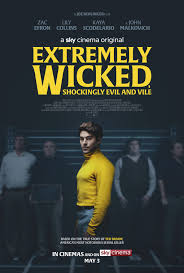Ted Bundy: Extremely Wicked, Shockingly Evil and Vile

movie poster
May 24, 2019
Zac Efron starred as Theodore Bundy in Netflix’s new original film, Extremely Wicked, Shockingly Evil and Vile. When the movie begins, Ted is talking to a woman through a glass partition; they are obviously in prison. The scene moves to a bar where Ted is flirting with a brown-haired woman whose hair is parted down the middle. “This is my last quarter, better make it a good one.” he flirts.
The film glorifies a man who murdered upwards of 50 women. Bundy is portrayed as a sexy, troubled man who deals with strife through crime instead as one of the United States’ most infamous serial killers.
By starring Zac Efron, a teenage heartthrob, Bundy’s crimes are made insignificant compared to his ripped abs and charming smile. The film is portrayed through his fiancé, Liz’s, eyes, so, it makes sense that some of his sociopathic ways shine through, but the film did not give enough recognition to the heinous crimes he committed. While the goal was to show if through Liz’s perspective, they missed the mark by instead glorifying Bundy.
Another issue is that every female character is displayed as an air headed idiot. There are no strong female characters. Liz is depicted crying on her knees and getting drunk for the better part of the movie and Carole Ann Boone is shown as being a lunatic who gets pregnant by a serial killer. The film never shows any of their redeeming qualities. In real life these women must have been incredibly strong to make it through the grief of having loved a man who murdered 50 women.
Liz admits that she called in the tip to the police that incriminated Bundy as being the killer. The film shows her as being a snitch, but these must have been the toughest most grief filled moments of her life. She is a strong woman, but she was depicted as a shell of a woman who could not keep herself together.
Other than the final scene when Bundy was shown shoving a woman into his car with a hacksaw in hand, the movie does not show him committing any of the crimes.
The final credits named 30 of the women who Bundy admitted to killing on a black screen. The issue with this is the lack of substantial recognition. The women murdered had friends and families and were destined to do great things. If the movie had said where each of the women were from, how old they were, what their major in school was, or even a message from the families would have sufficed. Then,
the movie ends leaving a bad taste in everyone who watched mouth.
